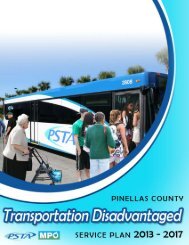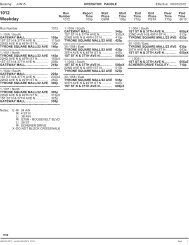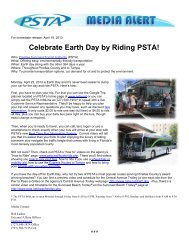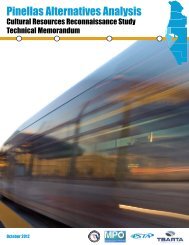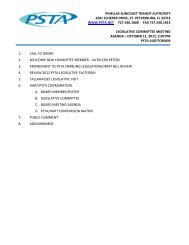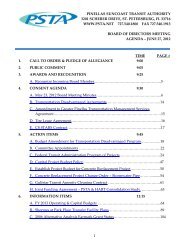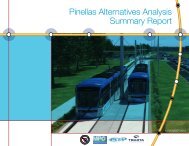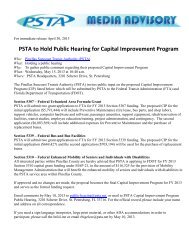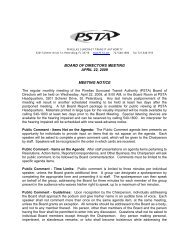DRAFT
FY 2020 - PSTA
FY 2020 - PSTA
- No tags were found...
You also want an ePaper? Increase the reach of your titles
YUMPU automatically turns print PDFs into web optimized ePapers that Google loves.
Regional Transportation IssuesOn May 22, 2009, TBARTA adopted “A Connected Region for Our Future: Tampa Bay Area RegionalTransportation Master Plan Vision.” The vision reflects a significant future investment in regional transitservices in Pinellas County, including bus rapid transit, express bus services, short-distance rail, andconnection to the Tampa-Orlando HSR. In addition, the TBARTA Master Plan reflects a substantial localsupporting bus network to feed the regional network and provide local bus circulation throughout PinellasCounty.FDOT, TBARTA, PSTA, and the Pinellas County MPO, are collaborating on two major transit planningendeavors to be performed in the Tampa Bay area that will impact the future of public transportationservices in Pinellas County. The Howard Frankland Bridge Study will be looking at premium transit servicealternatives over the Howard Frankland Bridge, one of three bridges connecting Pinellas and HillsboroughCounties over the Tampa Bay. The Pinellas County AA will be assessing the feasibility of rail service inPinellas County.Implications – As TBARTA moves forward with funding and implementation of the regional masterplan, it will be critical for PSTA to continue participating in regional transit planning efforts andproject implementation. The timeframe for implementation of regional transit services will be acritical consideration for PSTA in its decisions regarding future local bus service and itsconnectivity to the regional transit network. Additionally, the Howard Frankland Bridge Study andPinellas County AA provide an excellent opportunity to evaluate and implement feasible regionalconnections, including connection to HSR service in Downtown Tampa.Socioeconomic TrendsPinellas County’s population is projected to increase by 6 percent from 2010 to 2035 (938,556 to 998,301),according to forecasts derived from Traffic Analysis Zone (TAZ) data. Existing land use efforts to developtransit-oriented development (TOD) could impact this projection significantly. Seasonal populationestimates contribute an additional 8 percent to the permanent population figures. Additionally, a largeportion of bus passengers are elderly and/or physically impaired.Implications – PSTA must strive to meet transit demand as the population continues to grow inPinellas County. As population grows and ages, the role of transit will become an increasinglymore important component of transportation solutions in the county.Transit markets can be organized into three major categories: traditional markets, discretionary markets,and regional markets. The traditional market includes individuals who have no or limited transportationTindale-Oliver & Associates, IncPinellas Suncoast Transit AuthoritySeptember 2010 6-9 Transit Development Plan




